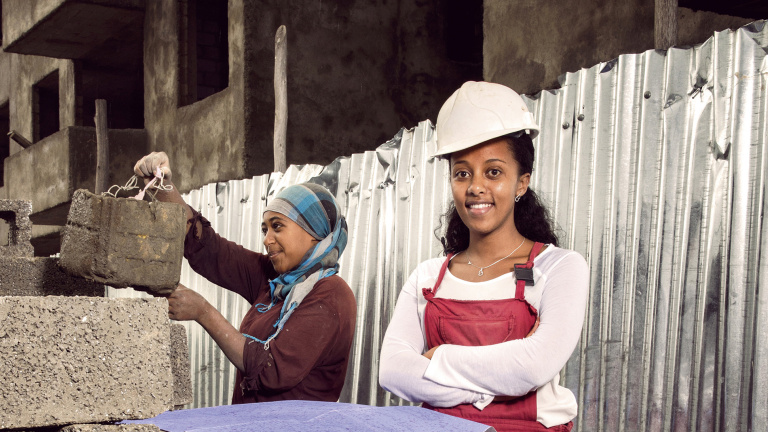
Youth employment opportunities in African agrifood systems
Rapidly transforming agrifood systems has the potential to drive the expansion of youth employment and broad-based economic development in sub-Saharan Africa. Focusing on Nigeria, Rwanda, and Tanzania, this article highlights the most promising opportunities and needed policy and programme changes.
Africa has the youngest population in the world, with almost 200 million people between the ages of 15 and 24 – a number expected to double by 2045. Job creation has not kept pace: 60% of Africa’s unemployed are youth and even more are underemployed. Citizens across 34 African countries regard unemployment as the top problem facing their nations. There is an unprecedented opportunity for economic and social development if the talents of this increasingly better-educated generation can be tapped. Alternatively, in the absence of a significant expansion of economic opportunities, Africa’s youth may also present a threat to social cohesion and political stability.
This article summarises the main findings from the Agrifood Youth Employment and Engagement Study (AgYees), one of the first studies to comprehensively examine the potential for and challenges to expanding youth employment in Sub-Saharan Africa’s agrifood systems – the set of activities, processes, people, and institutions involved in supplying food and agricultural products. AgYees was undertaken by Michigan State University in collaboration with The MasterCard Foundation.
Two analytical tracks generated insights into cost-effective strategies and programmatic entry points most likely to improve employment and livelihood options for youth. The strategic policy and foresight analysis reviewed economic megatrends for Rwanda, Tanzania and Nigeria, and projected how economic changes – specifically farm productivity growth, changing farm size distributions, and dietary transformations – will affect future job prospects for rural and urban African youth. A complementary agrifood landscape analysis for Rwanda and Tanzania examined the economic and policy environment affecting youth engagement with the agrifood system, assessed the supply and demand for related workforce training and perceived gaps, and distilled best practices and lessons learned related to youth economic programming.
Strategic policy and foresighting analysis
Major dynamics are underway in African employment: labour is moving sharply out of farming as economies transform, yet farming remains extremely important for livelihoods and economic growth. The off-farm agrifood system is growing very rapidly in percentage terms and will offer important opportunities for new businesses, but it will not match farming in the absolute level of new job creation for at least ten years. Specific findings include the following:
African economies have been transforming rapidly over the past 15 years, with generally rapid but highly variable exit rates of labour from farming into off-farm segments of the economy. The exit rate from farming has been the most rapid in Rwanda, followed by Tanzania, and slow or no exit in Nigeria. These findings are consistent with the broader literature, including on the negative effects of natural resource booms on economic transformation.
When computed as full-time equivalents (FTE), farming accounts for 43% to 48% of the labour force in Tanzania, 53% in Rwanda, and 34% in Nigeria. The proportion of the labour force in the off-farm segments of the agrifood system is about 8% in Rwanda, 17% in Tanzania, and 23% in Nigeria. The off-farm sector outside the agrifood system, mainly commerce and transport, construction and the public sector, employs more: roughly 37% in Rwanda, 35% in Tanzania, and 43% in Nigeria.
Employment in the off-farm portion of the agrifood system is growing much more rapidly in percentage terms than employment in farming, but the growth is from a lower base, and thus the contribution to new jobs in off-farm employment is smaller than that of farming.
The potential role of the off-farm agrifood system in new employment varies greatly across countries. Farming’s contribution to new job creation is highest in Nigeria and lowest in Rwanda. The off-farm agrifood system will contribute between 18% and 22% of all new FTE jobs in Tanzania over the next five years compared to 31% to 34% for farming. In Nigeria, the off-farm agrifood system currently accounts for 22% to 24% of jobs but only 18% of FTE new job growth, due to a very slow transition of the work force out of farming. In Rwanda, the off-farm agrifood system accounts for only 8% of jobs and 11% of job growth, about one-third that of farming.
The pace of economic transformation from farming to off-farm employment is directly related to agricultural productivity growth, consistent with historical patterns of growth in Asia. Rwanda, having experienced the highest agricultural productivity growth over the past decade among the three focus countries, has experienced the most rapid decline in the share of the labour force engaged in farming. In contrast, slow agricultural productivity growth in Nigeria is associated with very little change in farming’s share of the labour force there. The literature suggests that agricultural productivity growth, especially if broadly based, will generate strong multiplier effects that expand job opportunities in the downstream stages of the agrifood system as well as in the broader off-farm economy.
A key constraint to promoting labour productivity growth in farming is access to land, especially in land-scarce regions like Rwanda. Population pressures, increases in world food prices, and associated rising interest in Africa’s arable land are driving up land prices in the region, limiting the ability of youth, in particular, to access land.
In all three countries, food away from home (FAFH) should generate high quality jobs for youth. Because the FAFH sectors are much larger in Nigeria and Tanzania, activities and programming focused in this sector are likely to yield significant job growth. FAFH in these two countries offers the most rapid and largest growth in demand of any type of food, and the most rapid growth in output per worker in each country. Wages in these sectors (or returns to labour in own employment) are likely to be attractive and rapidly improving.
Food manufacturing in Tanzania offers the highest output per worker, the second-highest rate of growth in output per worker, and fairly large employment absorption, at 5% of all new jobs. In all three countries, results suggest that food manufacturing should offer high quality jobs, but with a much larger number of jobs in Tanzania than in Rwanda and Nigeria.
Fresh produce (fruit and vegetables) and dairy offer strong growth prospects for young farmers in Rwanda. For each, local demand is growing rapidly and export possibilities are strong.
FAFH stands to benefit women in Nigeria and Tanzania especially, where 90% and 71%, respectively, of all FTE employment in the sector is female.
Agrifood landscape analysis
Both Rwanda and Tanzania experienced impressive economic growth during the 2000s. Rwanda’s GDP growth averaged 8% between 2001 and 2014 and was accompanied by a 20-point reduction in poverty. Rwanda’s progress was facilitated by agricultural policies and investments that resulted in significant improvements in on-farm agricultural productivity, lifting the incomes of rural families. Rwanda’s severe land constraint limits further agricultural area expansion and especially youth access to land.
Unlike Rwanda, Tanzania’s economic growth has concentrated mainly in urban areas, driven by capital-intensive sectors, including mining, telecommunications, construction and banking. Except for construction, these sectors create few jobs directly. The Tanzanian agrifood system’s rate of growth has been consistently lower than other sectors, leading to a slower decline in poverty in rural areas, rising urban-rural inequality, and accelerating rural-to-urban migration. Tanzania faces the dual challenge of achieving faster growth while accelerating the shift of its labour force, especially youth, to more productive work. In contrast to Rwanda, Tanzania is well endowed with natural resources, including potential to expand agricultural land. In both countries, limited youth access to land and finance severely constrains youth agrifood opportunities. Specific findings include the following.
Agriculture is widely perceived by youth as an unappealing, traditional, labour intensive farm activity, not as a potentially high-profit business activity that involves a spectrum of new opportunities on and off the farm connected to marketing, processing, packaging, and food service, in addition to on-farm production.
There is a significant gap between the skills demanded by the private sector and those supplied by formal programmes and informal education and training programmes, including specialised technical skills, entrepreneurial/business skills, and soft skills.
Challenges remain in reaching out-of-school, rural youth via informal training, especially expanding the availability of informal learning opportunities that are linked to institutionalised technical and vocational education and training (TVET) and tertiary systems and are potentially more sustainable.
Small and medium enterprise (SME) development is a critical lever for connecting skills development and access to financial resources with concrete economic opportunities that lead to expanded youth employment, in line with agrifood sector comparative and competitive advantage.
Youth entrepreneurs face a steep learning curve in starting businesses and responding to market demands on an ongoing basis. The reluctance of financial institutions to lend to youth entrepreneurs and high rates of startup failure suggest the importance of providing a longer-term incubator environment where young people can practise essential technical and business skills as they are mentored, without the risk of catastrophic failure.
Youth entrepreneurs engaged in SMEs require assistance to analyse market potential, identify priority policy and regulatory issues, and access specialised training to address emerging downstream challenges, including meeting local and international food safety standards and developing low-cost packaging.
Although youth and women constitute the rural majority in both countries, few existing analyses examine factors affecting the development of specific value chains using youth as well as gender lenses.
Recommendations
A number of recommendations for youth-related programming in Rwanda, Tanzania and Nigeria can be derived from our analysis. These include:
- support action-oriented research and knowledge on strategies and policies that will raise agricultural productivity growth and economic returns to labour in farming, including land tenure policies;
- pursue a mixed programme strategy to increase youth economic opportunities both on and off-farm; focus programming especially on value chains and commodities for which consumer demand is expanding rapidly, including fresh and processed fruits and vegetables, poultry, fish, dairy and high-demand cereals and oilseeds.
- develop and implement comprehensive youth employment strategies;
- work to change youth mindsets about agrifood system-related opportunities;
- accelerate the application of ICT and other advanced technologies to agrifood system problems;
- expand agrifood system training programmes and improve curricula;
- increase private sector engagement in training programmes;
- integrate more and higher quality experiential learning in a cost-effective way;
- institutionalise monitoring, learning and communication;
- ensure that SME clusters can access up-to-date training, technologies, and market information, and identify and implement options for addressing policy/regulatory issues; and
- mainstream gender and youth in all programmatic interventions.
This article summarises some of the insights of Allen, A. et al. (2016), Agrifood Youth Employment and Engagement Study (AgYees), Michigan State University.
About the authors
Andrea Allen, Julie Howard, M. Kondo, Amy Jamison, Thomas Jayne, J. Snyder, David Tschirley, and Kwame Felix Yeboah are all at Michigan State University.
Read the full magazine issue





